Every prepper should have handy a bug-out bag, or BOB. This is a central piece of equipment to many disaster and crisis response plans, as it is the BOB which will carry all of the supplies and assorted gear that a person anticipates needing when the time comes to evacuate to someplace safer. If you are going to be roughing it out of doors or in the ruins of society, you’ll need a bug-out bag.
If you have spent any amount of time in or around the prepper-sphere you will have no doubt noticed that the size, type and particularly the contents of a bug-out bag are subjects of constant discussion.
What kind of items are best, which ones belong, which ones are too heavy which are indispensable etc., etc. This is with good reason, as one must always weigh the need or desire to bring along a certain item against how much it will contribute to the weight and bulk of the BOB itself.
We can talk all day about what you should bring, but it might be more instructive to talk about what you definitely should not put in your BOB.
Some items are too restrictive, too specialized or just too poorly thought out to warrant inclusion and that means you should ditch them or leave them at home. In this article we will share with you 10 bug-out bag items you will regret buying.
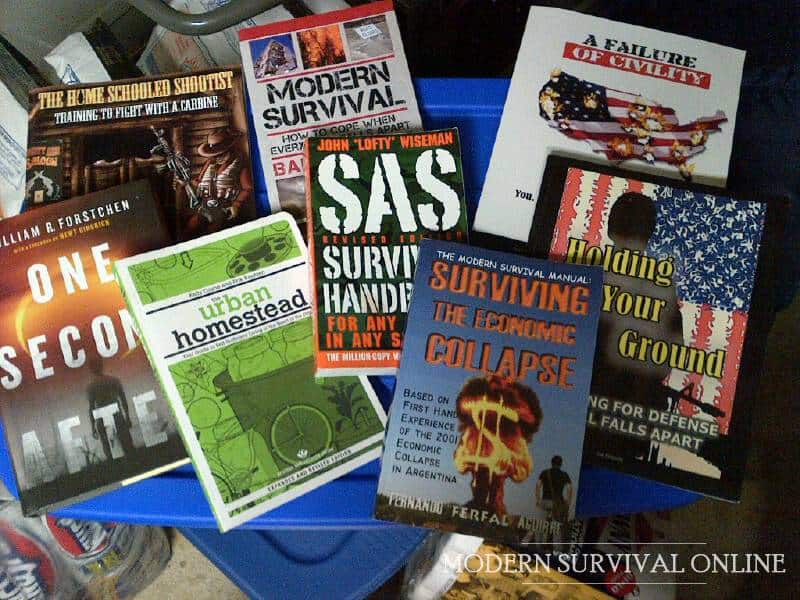
#1. Bound Books
I have little doubt I already lost our readers out in cyberspace who happened to be bibliophiles like myself. Unfortunately for all the book lovers in the audience, bound paper and ink books are very heavy and very bulky for their size.
This is unfortunate because books of this nature, especially technical and survival manuals, are an excellent prep, and worthy of inclusion in your BOB.
No one knows everything, and even a prepper who is very learned and knowledgeable in a certain subject might find that knowledge temporarily deserting them when they need it most due to stress. This is where a bound a book can come in handy.
Unfortunately, including anything larger than a compact size format survival manual or other similar work will prove weight and space prohibitive in most loadouts.
A better option by far especially for those preppers who are equipped with high efficiency off-grid charging systems is to utilize a tablet or e-reader that can carry an entire library’s worth of material in a device that takes up only a fraction of the room, and a quarter of the weight.
I know traditionalists will balk at such a notion, but the notion that you might carry over a dozen pounds of books with you in order to cover your bases is equally unthinkable.
Any book that you choose to take with you and your BOB must be a value-added proposition, not just when it comes to content but also when it comes to weight and size.
#2. Large Binoculars or Spotting Scope
An optical aid that can help you see better farther is always a smart inclusion to a bug out bag. Even those with eagle vision are hampered by very human limitations.
Optical magnification can help you see things that you would otherwise miss, potentially helping keep you out of trouble, avoid hazardous conditions or see someone at a distance that is trying to signal you.
Among the two most popular solutions to this requirement are binoculars and monoculars, or spotting scopes.
Where some peppers go wrong when purchasing one or the other is buying the largest and most powerful device that they can find, or afford.
Whether it is through a misguided belief that bigger is always better, or that they will have a very real requirement to utilize such powerful optics capabilities, the end result is the same: a ton of money spent on an overly large and overly heavy optic.
With very few exceptions this is a mistake. Most folks will do just fine with modern, compact binoculars or spotting scopes ranging anywhere from 10 to 15 power.
These devices are smaller than ever and more affordable than ever thanks to advances in materials science and manufacturing technology. Even better, they are usually available at a price that won’t make your wallet scream for mercy.
Think very long and hard, twice, before you commit to a gigantic pair of binos or an enormous monocular for your bug out bag. Chances are good you will quickly come to resent it in an emergency.
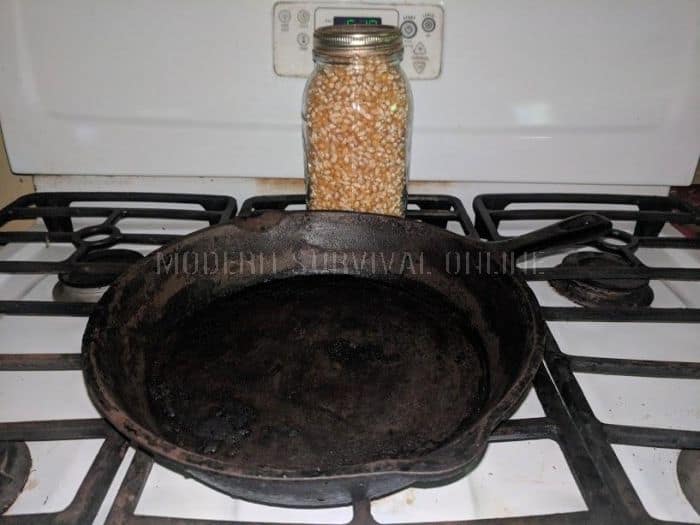
#3. Cast Iron Cookware
Smart preppers that are packing a BOB will very literally watch every ounce on the scale in order to keep the load as light and the bag as lean as possible. There is a reason there is such a preponderance of ultra lightweight camping gear on the market.
Seasoned backpackers know that ounces make pounds, and pounds make pain- and blisters. The total load that your BOB must carry is not just a factor when considering the durability of the pack itself, but also the durability of the person who carries it!
One area where people commonly go wrong when choosing cookware for their BOB is picking traditional camping staples like cast iron pans or pots.
Cast iron cookware is undeniably awesome and has much to commend it in the kitchen, or even when overlanding, but for prepping its enormous weight completely disqualifies it from consideration unless you will only ever be moving using vehicles or a team of strong mules.
Cast iron might be available in several clever outdoor cooking focused configurations and even in sizes small enough that it could be tempting to toss it into your pack.
Do not give in to sentimentality! Surviving is not camping, and if you feel like you’re on a camping trip the situation is probably not bad enough to warrant bugging out anyway!
#4. “Briefcase” Stove
Any preppers who already enjoy a healthy outdoor lifestyle of backpacking, camping, tailgating and similar activities probably has tooling around in a closet or in the garage one of the old fashioned and charming “briefcase” style camping stoves as popularized by Coleman.
You know the type I am talking about: the kind that opens up like a briefcase before laying flat on the ground and connecting to a small propane bottle.
Although you cannot argue with them from a cost-effectiveness and simplicity standpoint (not to mention offering two full size or nearly full-size burners), these contraptions are still too big and too bulky to warrant inclusion in your loadout.
They work fine for a family camping trip, and they are compact by the standards of the average tailgating outing, but when we are working within such a limited space and weight envelope as a bug-out bag these things might as well be a bank vault.
Ditch the old and trusty standby for one of the modern varieties of jet style camping stoves which typically have a footprint that is much smaller while weighing much less, nearly nothing when detached from their fuel bottle.
These ingenious little stoves have become the modern standard for all kinds of outdoor expeditions for a reason.
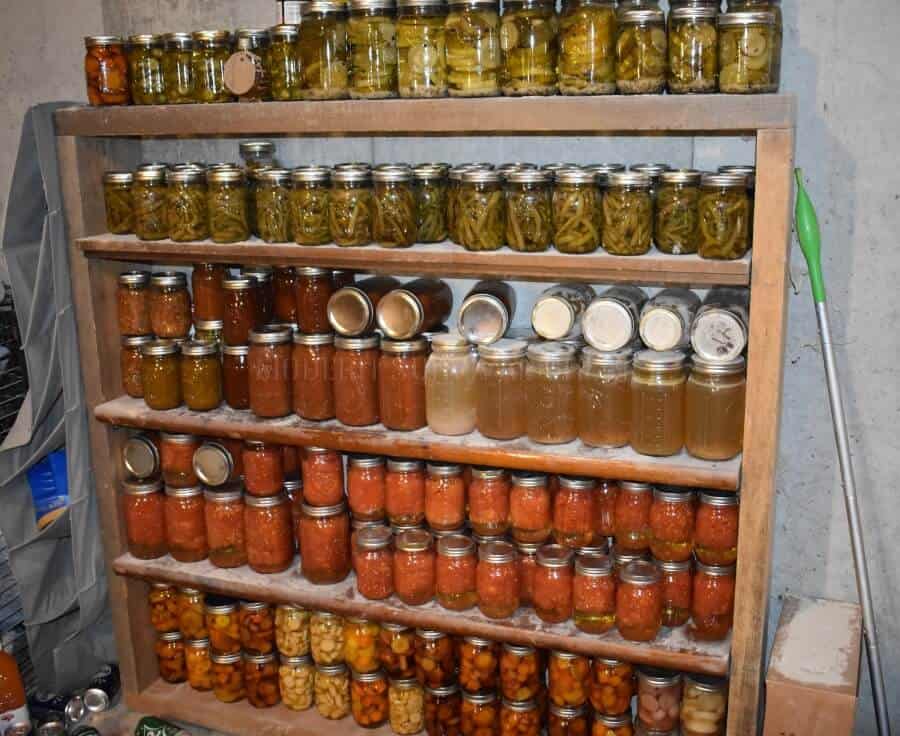
#5. Canned Food
This entry probably had some of you doing a double take. I have no doubt you have heard or read I and other authors talk about canned food as a nearly ideal and available item for preparation in the prepping context.
That is true, and while canned food is great and I do recommend it for general preparation it makes a very poor choice for inclusion into a bug-out bag.
The reasons why are obvious. Canned food is heavy both in container and water weight, and is difficult to pack smartly in your bug out bag thanks to its cylindrical shape.
Whatever its other attributes and whatever kind of food it contains, you will want to sharply limit the space you dedicate to canned food in your BOB to only one or two choice luxury items that you simply cannot live without.
You should have the expectation that you will not be eating the way you normally eat and dining on what you normally dine upon when the time comes to call on your bug-out bag.
In fact, going with such trail ready staples as beef jerky, trail mix, granola and dehydrated emergency foods or MRE pouches should be considered the norm. If you want to toss in a can of Spam or maybe some tuna that is fine but don’t overdo it.
#6. GMRS / CB Radio
This is bound to be the most controversial inclusion on this list. Though you are wise to always keep on hand on emergency radio that is able to receive disaster and situation broadcasts from government agencies, a heavy and comparatively bulky GMRS or CB radio set is not something that the vast majority of preppers will ever need for the purposes of a bug out.
I say bug out specifically because consider the situation you are departing from against the location you are heading toward.
It is highly likely that the people you are traveling with will be traveling, well, with you, meaning that radio communication is not necessary to keep in touch. Similarly do you have people expecting you at your bug out location, people that you might need to radio ahead to inform them of your status? Again, probably not.
If it is absolutely necessary for one or all members of your survival group to remain in contact while traveling in relatively close proximity you would do just as well to obtain several high quality hand radios or walkie-talkies.
Though they lack the range of larger, proper radio sets they are nonetheless entirely adequate for most near-distance communications.
#7. Gas Mask
It is hard to argue against the inclusion of a gas mask when you consider it from the perspective that air, oxygen, is the single most vital survival necessity considering that a human being can live only minutes without it.
What else is a gas mask but a tool for ensuring the contaminated air can be safely breathed? Ergo, a gas mask is surely a smart inclusion for a bug-out bag carried by the savvy prepper.
Not so fast. While you are wise to be concerned with all kinds of airborne hazards even during mundane and common natural disasters, a gas mask is rarely the best choice.
Against these common threats, there is nothing that a gas mask will do to purify the air before you inhale it that a smaller, lighter and cheaper respirator won’t do.
A gas mask is only truly necessity when you are facing a contaminant or chemical agent that will harm the eyes or penetrate the skin, and in the former case you are still often better off making use of goggles in conjunction with a respirator while in the latter case a fully sealed CBRN suit is required for proper protection.
Gas masks are bulky, awkward to carry and required only for very specific and mercifully very rare atmospheric threats.

#8. Mechanic Tools
Some preppers adopt a “kitchen sink” mentality when it comes to including tools in their bug out bag, with their reasoning being that a good set of proper tools will enable them to repair or repurpose any mechanical or technological devices that they come across and thereby boost their survival chances.
One of the more popular inclusions in this category is a set of mechanics tools, ratchets, sockets and all.
The reasoning is fairly sound, but it is the priority and packing order that I take issue with. For preppers who focus on utilizing automotive transportation as part of their bug-out plan, they absolutely must include a proper roadside repair kit for the vehicle and that definitely includes tools like these used for the purpose. But those tools should be packed with the vehicle kit, not inside the bug out kit themselves.
If you are forced to bug out and abandon your vehicle chances are you won’t need the tools at all. For preppers who are bugging out without making use of a vehicle, they definitely won’t need the tools.
There is no other way around it than to say tools of all kinds, even the cheap ones, are made of metal and that means they are heavy as a rule. Though we cannot get by without some metal tools we must always, always justify the inclusion of any heavy, metal gear by our likely requirements.
#9. Grappling Hook
Grappling hooks might at first glance seem like the ideal tool for any prepper that might have to scale or descend a sheer vertical surface, especially if you don’t have much experience tying off ropes.
What could be simpler than using a grappling hook for the purpose? Simply snag a hard point with the hook, give the rope a tug and start ascending or descending. Easy? You bet!
Easy, maybe. Sure or certain, no way. Discounting the fact that any grappling hook is going to be large, cumbersome and difficult to carry or store, a grappling hook is far from a truly secure attachment point for ropes used for climbing, descending or hauling goods.
They aren’t even particularly useful for casting or throwing a line over a long distance since you can do the same thing with a rock or a sock filled with gravel.
The biggest shortcoming with grappling hooks when used for climbing is that you will never be truly certain that they are properly secure.
What is to say that a prong or two on the hook has more than a tenuous grip on whatever has snagged it? How will you know it is going to slip or fail until you are well on your way up the rope? To say that using a grappling hook for the purpose might leave you fatally surprised as an understatement.
Save the superhero fantasies for your day dreams and leave the grappling hooks at home.
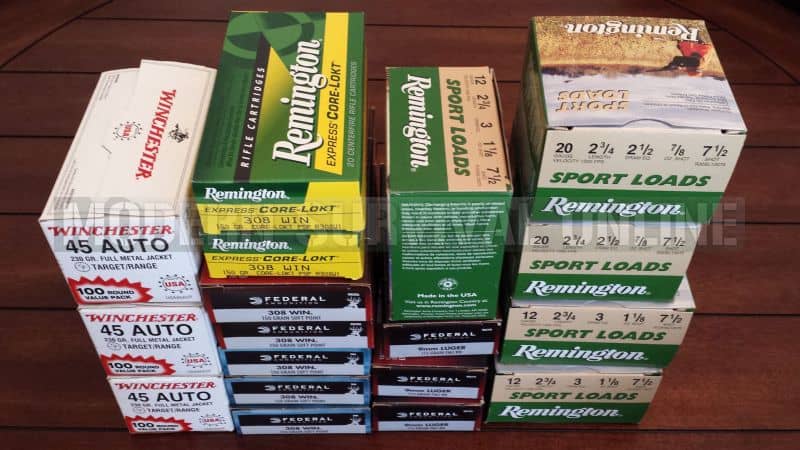
#10. Too Much Ammo
This will probably be the most heretical statement that some readers will read today. It is easy to fall into the trap of thinking that, just because you are facing some dreadful disaster, the only way to combat it is by loading down your bag with 50 lbs. of ammunition.
I mean, what’s 30 or 40 AR magazines between friends, right? I’ll tell you what it is, and that is an awful, awful lot of weight.
Make no mistake the need for security during a crisis is entirely real, and the best way to provide security against human threats is with a firearm and the appropriate training on how to handle it and yourself in a fight.
At the end of the day, ammunition is cheap insurance, but you must keep in mind it is not the only threats you will be facing! Exposure, dehydration, starvation, getting lost, getting hurt and so much more all await the unwary and ill-prepared.
You must consider how likely you are to get in a fight, and how much ammo will likely be required to extricate yourself from that fight.
Ask yourself how many times you will likely need to fight while en route to your bug-out location, and then how likely it is you’ll need to fight to defend your new home. Only by reasoning that out can you hope to make an informed decision on how much ammo you should bring.
Conclusion
There are lots of things you should include in your BOB, and just as importantly many things you shouldn’t. You must make every effort to keep your BOB light, lean and efficient, and that will be hard to do when you fill it up with items that are too bulky, heavy or useless.
Take the time to review our list and make sure you don’t hamper your BOB and yourself with this gear.
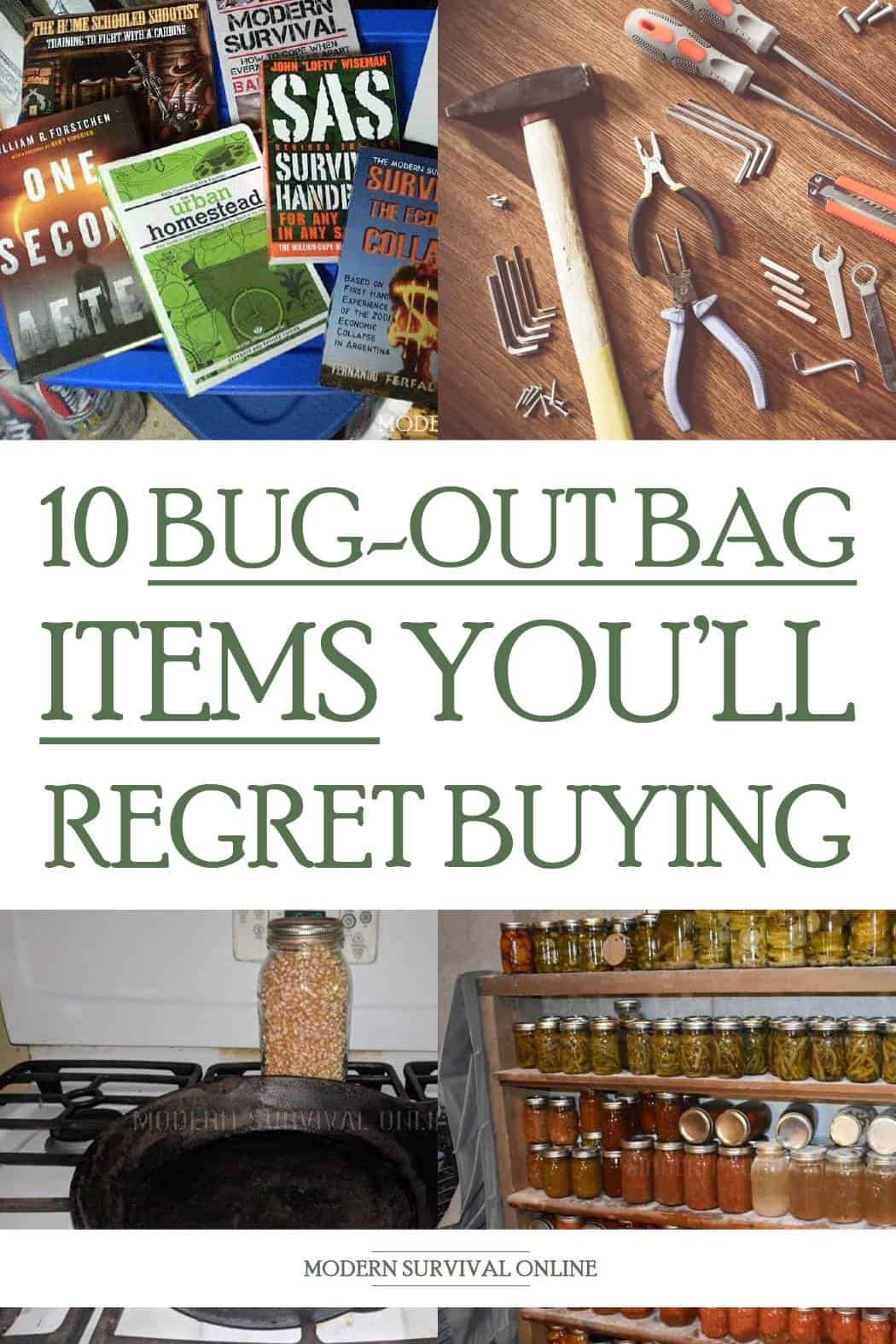

Like what you read?
Then you're gonna love my free PDF, 20 common survival items, 20 uncommon survival uses for each. That's 400 total uses for these dirt-cheap little items!
We will not spam you.
I’ve never hiked with a backpack, but just carrying a purse gets heavy after a while. I know that weight matters. And I’m a 70 year old, old lady. LOL
My thought on #4, what good is that “jet style camping stove” when you run out of fuel? I recommend you ditch the stove and plan on campfires.
Other than that, I think you make very logical conclusions on your recommendations…of course on #10… how can we ever define enough?!?!? 😉
There are many “stick stoves” that fold flat and will hold a small pot or kettle (or mess kit pan). These need nothing more than a few pinecones or tinder sized twigs to get up to a good heat. Just don’t use it in an enclosed space because of smoke and carbon monoxide..